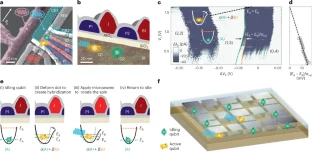Phys.org January 12, 2023
The electron spin forms a qubit that is naturally robust to electric fluctuations. However, a common control strategy is the integration of micromagnets to enhance the coupling between spins and electric fields, which, in turn, hampers noise immunity and adds architectural complexity. An international team of researchers (Australia, Japan, Germany, Canada) used switchable interaction between spins and orbital motion of electrons in silicon quantum dots, without a micromagnet. The weak effects of relativistic spin–orbit interaction in silicon were enhanced, leading to a speed up in Rabi frequency by a factor of up to 650 by controlling the energy quantization of electrons in the nanostructure. They demonstrated fast electrical control in multiple devices and electronic configurations. Using the electrical drive, they achieved a coherence time T2,Hahn ≈ 50 μs, fast single-qubit gates with Tπ/2 = 3 ns and gate fidelities of 99.93%. According to the researchers high-performance all-electrical control improves the prospects for scalable silicon quantum computing…read more. TECHNICAL ARTICLE

Electrostatic quantum dots with tunable energy spectrum. Credit: Nature Nanotechnology (2023)